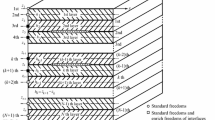Abstract
It is known that delaminations are the most frequent causes of failure in laminated structures, particularly under compressive loads. The presence of delaminations leads to a reduction in the overall strength of the structure. In addition, they tend to grow rapidly under operating loads, causing a further reduction in structural strength, and finally, leading to fatal structural failure. In this paper, a simple method is derived to estimate the pointwise energy release rate distribution along the delamination front based on the 3-dimensional equivalent domain integral [1].
Access this chapter
Tax calculation will be finalised at checkout
Purchases are for personal use only
Preview
Unable to display preview. Download preview PDF.
Similar content being viewed by others
References
Nikishkov G. P.; Atluri S. N. (1987): Calculation of fracture mechanics parameters for an arbitrary 3-dimensional crack by equivalent domain integral method. Int. J. Numer. Meths. Engg. 24, 1801–1822.
Chai H.; Babcock C. D.; Knauss W. G.(1981): One-dimensional modeling of failure in laminated plates by delamination buckling. Int. J. Solids and Struct. 17(11), 1069–1083.
Naganarayana B P and Atluri S N (1994): Energy-based methods for delamination growth prediction in a multi-plate model. J. Computational Mechanics (To appear).
Huang B-Z.; Shenoy V. B.; Atluri S. N. (1994): A quasi-conforming triangular laminated composite shell element based on a refined first order theory. Comput. Mech. 13, 295–314.
Huang B-Z.; Atluri S. N. (1994): A simple method to follow post-buckling paths in finite element analysis. Internal Report, FAA Center for Computational Mechanics, GeorgiaTech., Atlanta, USA.
Naganarayana B. P. (1995): Incremental iterative strategies for automated post-buckling analysis. Internal Report, National Aerospace Laboratories, Bangalore, India, 1995.
Naganarayana B. P. (1991): Consistency and correctness principles in quadratic displacement type finite elements. Ph.D. Dessertation, Indian Institute of Science, Bangalore, India.
Evans A. G.; Hutchinson J. W. (1984): On the mechanics of delamination and spalling in compressed film. Int. J. Solids and Struct. 20(5), 455–466.
Author information
Authors and Affiliations
Editor information
Editors and Affiliations
Rights and permissions
Copyright information
© 1995 Springer-Verlag Berlin Heidelberg
About this paper
Cite this paper
Naganarayana, B.P., Atluri, S.N. (1995). Equivalent Domain Integral for Delamination Growth Estimation. In: Atluri, S.N., Yagawa, G., Cruse, T. (eds) Computational Mechanics ’95. Springer, Berlin, Heidelberg. https://doi.org/10.1007/978-3-642-79654-8_416
Download citation
DOI: https://doi.org/10.1007/978-3-642-79654-8_416
Publisher Name: Springer, Berlin, Heidelberg
Print ISBN: 978-3-642-79656-2
Online ISBN: 978-3-642-79654-8
eBook Packages: Springer Book Archive




